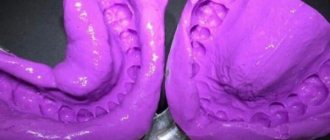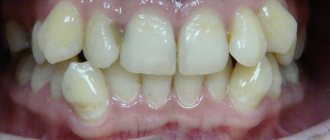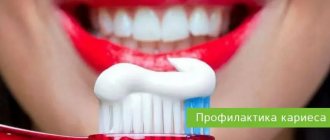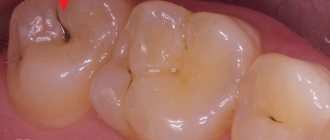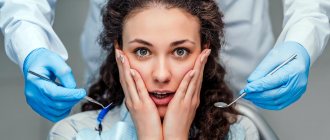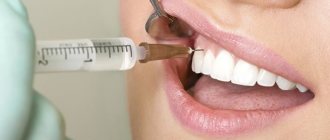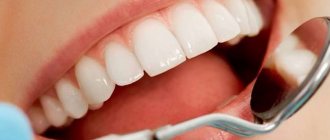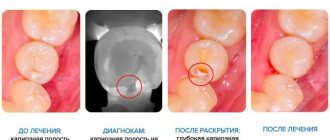Mechanism of occurrence
The development of caries begins from exposure to acids produced by bacteria living in the oral cavity. The worse your oral hygiene is, the more food debris and plaque are retained in it, which are ideal for feeding these organisms. Acidic compounds wash minerals out of the enamel, leaving pores in their place. At the same time, the tooth surface loses its shine, stains and microscopic cracks appear. After the white spot stage, a violation of hard tissues is noted, and then the process becomes irreversible.
After demineralization of hard tissue, its destruction occurs. Further, the pathology develops as follows: superficial – middle – deep caries. Since while wearing braces, oral hygiene is complicated by foreign bodies found in it, such diseases are more common in patients with braces than in other people.
Preventive measures
To avoid the need for repeated treatment of caries with braces, you need to take measures. To prevent dental diseases it is important:
- use orthodontic brushes, irrigator and floss for high-quality cleaning of teeth and interdental space,
- use fluoride-containing pastes and rinses for everyday hygiene,
- regularly visit the orthodontist - during the examination, the doctor will not only assess the progress in treatment, but will also be able to detect the first signs of caries.
Causes
There are three main reasons for the occurrence of carious lesions while wearing braces:
- Even for those patients who are responsible for brushing their teeth, when there are locks and arches in the mouth, it can be difficult to carry out the procedure efficiently. Food not only gets trapped under the elements of the orthodontic structure, but also ends up outside the range of action of the toothbrush.
- During installation of the system, microcracks may appear between the locks and the enamel. This point depends on the experience and skills of the dentist. In addition, cracks sometimes appear during wear if the adhesive material has lost its quality characteristics. A loose fit of the locks leads to small particles of food getting into the cracks, which are almost impossible to remove from there yourself. By the time the caries goes beyond the area where the lock is attached, it will have time to penetrate deep into the dentin, and sometimes the pathological process has already affected the pulp.
- If during treatment with braces the lock comes unstuck, but remains in place due to the pressure of the arc or other structural elements, this also becomes an “entry gate” for the proliferation of bacteria. This picture may persist for some time, during which time the tooth structure can suffer significant damage.
Cons of Flash Free
The main disadvantage of this technology is the increase in the cost of treatment with braces. Individual production of the backing for each bracket is a complex technological process that takes some time. And if you want to install such a bracket system , you will need to order it in advance.
Another disadvantage of this technology is that it is not available for brace systems from some manufacturers. So, if in your case you need a specific braces system, it may not be possible to make a special Flash Free backing for it.
Preparing for installation
Often, caries after removing braces is a consequence of the fact that dangerous lesions were present even before the system was fixed, but were not identified in time. To prevent this from happening, before starting the course, a detailed diagnosis is carried out to identify all possible problems. Existing foci of caries must be eliminated. Sometimes, when a porous enamel structure is detected, mineralization is carried out.
An integrated approach to preparing the dentition allows you to avoid unpleasant moments after removing braces by not 100%, but reduces the likelihood of their occurrence several times.
Pain from cold
Increased sensitivity of enamel to irritants is called hyperesthesia. Toothache in adolescents, as a manifestation of hyperesthesia in response to temperature exposure, develops due to easier transmission of impulses to the pulp, the sensitive part of the tooth, which contains nerve fibers. This happens as a result of numerous processes leading to a decrease in the protective properties of enamel. This can be caries and non-carious lesions of tooth tissue.
The second reason for pain from cold and hot is the exposure of the neck and root of the tooth when the gums sag. In the root area, the layer of enamel is much thinner than in the coronal part. Dystrophic processes in periodontal tissues quickly lead to the destruction of the periodontal junction and exposure of sensitive areas of the teeth.
Caries during treatment
Sometimes caries becomes active during the course. It is almost impossible to notice it on your own. Sometimes a dentist can see this using a mirror and other dental instruments and devices. But sometimes the outbreak is hidden behind a lock, so even a doctor cannot detect it during a visual examination. Then diagnostic methods such as x-rays come to the rescue. In the picture you can even see the cavity that has affected the deep structures of the tooth, if the visible part of which is hidden behind the bracket.
If such a source is detected, the situation should be corrected immediately, without waiting until the system is removed. Such a wait can lead to serious problems or even tooth loss, so treatment is carried out soon after diagnosis. If the lesion does not coincide with the places where the locks are attached, then during sanitation there will be no need to remove the structure; the dentist will be able to carry out all the necessary steps using tools and install a filling, and the orthodontic product will not interfere with him. As a last resort, you will have to remove the arc, which immediately upon completion will be returned to its original place and oriented as needed.
In cases where the outbreak is located under the lock of the brace, it will have to be removed. The doctor will tell you whether it will be possible to return it back, or whether this part should be made anew. It is important that specific pain should alert the patient and force him to go to his specialist for an unscheduled consultation, since tooth loss can disrupt the entire treatment plan. It will not be possible to correct the bite while losing teeth along the way, since then the support for installing the lock will be lost.
Caries at the end of the course
After removing braces, a problem is often discovered that was hidden by the locks, but did not cause any pain. As a rule, such lesions are not the largest, since deep cavities manifest themselves as pain even before removal.
Experts note that immediately after elimination, the unpleasant sensations at the site of the carious lesion sharply intensify. This is due to the fact that the enamel, after polishing and removing the remaining adhesive composition, becomes more sensitive, reacts sharply to sour, salty, and temperature changes, so the pain will be stronger.
The need for treatment after removal of the structure is a fairly common picture. It is advisable to carry it out immediately, before installing retainers, if a retention structure in the form of an arc is chosen, which is attached to the surface of the dentition facing the inside of the oral cavity. If a silicone aligner is used during the retention period, treatment can be delayed for several days.
Flash Free Method
The principle of Flash Free technology is the creation of an individual base for each tooth and each bracket. This technology is the result of development by 3M ESPE. They created a special material from very small polypropylene fibers, intertwined in a special way. The main feature of this material is that it compresses in the direction between the tooth and the bracket, but does not change in size in length and width. That is, it does not go beyond the bracket and does not form excess. An individual backing is made for each brace, strictly according to its dimensions and parameters. Next, this substrate is impregnated with a special glue, also developed specifically for this technique. It has several features:
- It does not spread over the surface of the tooth, as it has surface tension. On the surface of the tooth, the material looks like a drop of water on the surface of glass.
- It ensures reliable fixation of the bracket on the tooth not only through gluing, but also through the distribution of pressure between the tooth and the bracket.
- Due to its properties, this material is used in small quantities for fixation.
- The material practically does not absorb dyes and does not change color much during the treatment process.
Thanks to these features, Flash Free technology ensures a perfect fit of the bracket to the tooth - without gaps or excess material. 3M specialists also note that braces with Flash Free technology come off less often - in only 0.75% of cases (compared to 2.91% for braces fixed using the conventional method).
Prevention
Experts say that the risk of detecting caries after removing braces can be reduced almost threefold if you take a responsible approach to hygiene and adhere to all the rules for brushing teeth with braces:
- Regular brushing using a toothbrush with bristles of the stiffness recommended by the doctor. In addition to a toothbrush, you will need to purchase an irrigator, a special dental brush, and dental floss. All these devices should be used together, rather than choosing one of them.
- Cleaning should be done after every meal. If this is not possible during the day, then you can do this twice a day - morning and evening. The process should take 5-10 minutes. The rest of the time, when it is not possible to brush your teeth, you will have to make do with a thorough mouth rinse. It is also advisable to use a dental rinse, which inhibits the development of pathogenic bacteria and saturates the enamel with minerals.
- A complete review of the diet is necessary. Chewing gum and dishes with sticky particles should be removed from the menu. If there is anything stuck to your braces, you need to carefully remove the residue using a dental swab. It is important not to use excessive force to prevent the lock from falling off. Products that are too hard are not suitable, as biting or chewing may cause cracks. The same goes for foods and drinks that are too hot or too cold. You also need to give up chips, seeds, toffees, etc.
- During the course, you should not miss visits to the doctor who monitors the process. This will not only allow timely correction of the system, but will also ensure the identification of any carious lesions. If the patient is bothered by new sensations in the area of the dental arches, be sure to tell the orthodontist about this.
- Carrying out home hygiene procedures is not enough. In addition, periodic cleanings performed by the dentist are necessary. The frequency of such procedures will be determined by the doctor, focusing on the condition of the enamel, the rate of formation of soft and hard deposits, etc. The average frequency of dental cleaning is once every six months.
By following these requirements, you can maintain healthy teeth while wearing braces. After removal, the teeth will not only be straight, but also healthy.
Dentists about braces and risks
Braces are a system that consists of clasps and power arches (dental wire). The clasps are fixed to the tooth surface with special glue. By choosing a wire of a certain thickness and adjusting the system, the orthodontist changes the force of pressure with which the system acts on the teeth. Thanks to this, the process of moving teeth becomes completely controlled and predictable.
In theory, everything is simple: the doctor installs the structure and conducts a routine “technical inspection” of it, and the patient, throughout the entire period of treatment, provides thorough oral care using products specially designed for this. In fact, many people neglect the rules of hygiene. The accumulation of bacterial plaque in children and young adults occurs much more slowly than in adults, which is why teenagers often do not understand the need for daily oral care. The result of a careless attitude is the development of a number of complications, of which caries is often not the biggest problem.
